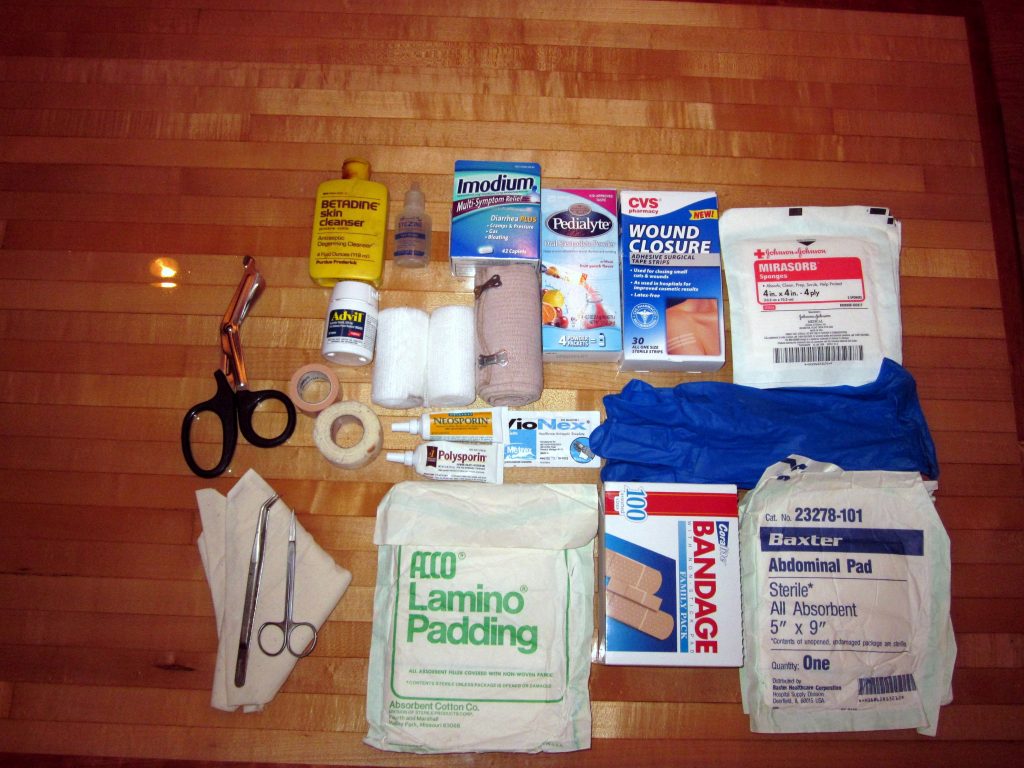<p style="text-align: justify;">Almost everybody will need to use a first aid kit at some point. It really is worth taking the time to prepare a kit and have it available for home and travel. First aid kits can be basic or comprehensive. What you need depends on how trained you are and the distance you might be from professional medical help. Ready-made first aid kits are available from stores, but you can make your own simply and inexpensively. If you are travelling, be prepared to take enough medication to last at least as long as you’ll be away. Keep your medical information with you. You need to be prepared to give it to emergency personnel in situations where first aid is only the beginning of care.</p>
<p style="text-align: justify;">Home first aid kits are usually used for treating minor traumatic injuries like cuts, burns, abrasions, stings, splinters, sprains and strains. You’ll need to include more in your travel kit, because you may not be able to access a pharmacy from where you are. You’ll need to pack any medication that you take on a regular basis and also include items to treat fever, nasal congestion, coughs, sore throats, mild pain, gastrointestinal problems, skin problems and allergies.</p>
<h2 style="text-align: justify;"><b>Making a First Aid Kit</b></h2>
<p style="text-align: justify;">Try to keep it small and simple. Fill it with multi-use items. You can use any container that allows you to see its contents well for a household kit. If it’s a travel kit you’re creating, you’ll be better off with a water-resistant, drop-proof container. Make up cases, bum bags and cheap nylon bags work very well and you can use resealable oven or sandwich bags to group your items. There’s no need to spend a lot of money on a fancy ‘medical bag’.</p>
<h2 style="text-align: justify;"><b>How to Use a First Aid Kit</b></h2>
<p style="text-align: justify;">Ensure you know how to use all of the items in your kit properly, especially the medications. Train your family to use the kit as well. It might be you who needs first aid! It might be worth going on a first aid training course to be sure you’ll be prepared in the event of an injury. Pack and use barrier items such as latex gloves to protect you from others’ bodily fluids. Check the kit bi-annually and be sure to replace expired medications.</p>
<p style="text-align: justify;"><img class="aligncenter size-large wp-image-2655" alt="What You Need In Your First Aid Kit" src="https://medusamagazine.com/wp-content/uploads/2015/01/What-You-Need-In-Your-First-Aid-Kit-1024x768.jpg" width="710" height="532" /></p>
<h2 style="text-align: justify;"><b>Where to Store your First Aid Kit</b></h2>
<p style="text-align: justify;">The best place to store your home first aid kit is in the kitchen. It’s where most family activities take place. The bathroom is too humid and this shortens the shelf life of items. The travel kit is for trips away from home so keep it in a suitcase or backpack. You should also keep a first aid kit in the car just like the one at home.</p>
<h2 style="text-align: justify;"><b>What to Put in Your Home Kit</b></h2>
<p style="text-align: justify;">You can buy all the items you need for your first aid kits at a well-stocked pharmacy. Ask the pharmacist for help in choosing the items.</p>
<p style="text-align: justify;">A home first aid kit should include:</p>
<p style="text-align: justify;">Adhesive tape</p>
<p style="text-align: justify;">Antiseptic spray or lotion &#8211; for itching rashes and insect bites</p>
<p style="text-align: justify;">4&#8243; x 4&#8243; sterile gauze pads &#8211; for covering and cleaning wounds or for use as a soft eye patch</p>
<p style="text-align: justify;">2&#8243;, 3&#8243;, and 4&#8243; Ace bandages &#8211; for wrapping sprained or strained joints, for wrapping gauze on to wounds or for wrapping on splints</p>
<p style="text-align: justify;">Adhesive bandages (all sizes)</p>
<p style="text-align: justify;">Diphenhydramine &#8211; oral antihistamine for allergic reactions, itching rashes. Avoid topical antihistamine creams because they may make the rash worse in some people.</p>
<p style="text-align: justify;">Exam gloves &#8211; for infection protection, and can be made into ice packs if filled with water and frozen</p>
<p style="text-align: justify;">Polysporin antibiotic cream &#8211; to apply to simple wounds</p>
<p style="text-align: justify;">Non-adhesive pads &#8211; for covering wounds and burns</p>
<p style="text-align: justify;">Pocket mask for CPR</p>
<p style="text-align: justify;">Resealable oven bag &#8211; as a container for contaminated articles or can become an ice pack</p>
<p style="text-align: justify;">Safety pins (large and small) &#8211; for splinter removal and for securing triangular bandage sling</p>
<p style="text-align: justify;">Scissors</p>
<p style="text-align: justify;">Triangular bandage &#8211; as a sling, towel or tourniquet</p>
<p style="text-align: justify;">Tweezers &#8211; for splinter, stinger or tick removal</p>
<p style="text-align: justify;">A list of family member&#8217;s medical history, any medications they take, their doctor, insurance company, and contact persons should be readily available.</p>
<h2 style="text-align: justify;"><b>What to Put in Your Travel Kit</b></h2>
<p style="text-align: justify;">A travel kit should contain everything in the home kit as well as:</p>
<p style="text-align: justify;">Antacid &#8211; for indigestion</p>
<p style="text-align: justify;">Antidiarrheal</p>
<p style="text-align: justify;">Antihistamine cream</p>
<p style="text-align: justify;">Antiseptic agent (small bottle liquid soap) &#8211; for cleaning wounds and hands</p>
<p style="text-align: justify;">Aspirin &#8211; for mild pain or heart attack</p>
<p style="text-align: justify;">Book on first aid</p>
<p style="text-align: justify;">Cigarette lighter &#8211; to sterilize instruments and to be able to start a fire in the wilderness</p>
<p style="text-align: justify;">Cough medication</p>
<p style="text-align: justify;">Dental kit &#8211; for broken teeth, loss of crown or filling</p>
<p style="text-align: justify;">Small torch</p>
<p style="text-align: justify;">Ibuprofen</p>
<p style="text-align: justify;">Insect repellent</p>
<p style="text-align: justify;">Knife (small Swiss Army-type)</p>
<p style="text-align: justify;">Moleskin &#8211; to apply to blisters or hot spots</p>
<p style="text-align: justify;">Nasal spray decongestant &#8211; for nasal congestion from colds or allergies</p>
<p style="text-align: justify;">Polysporin antibiotic ointment</p>
<p style="text-align: justify;">Oral decongestant</p>
<p style="text-align: justify;">Personal medications and items</p>
<p style="text-align: justify;">Phone card with a minimum of 60 minutes of time, some change for pay phones and a list of important people to reach in an emergency. A mobile phone and charger although service may be unavailable in many areas.</p>
<p style="text-align: justify;">Sunscreen</p>
<p style="text-align: justify;">Thermometer</p>

What You Need In Your First Aid Kit
